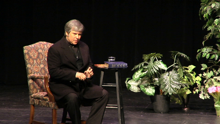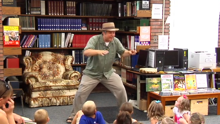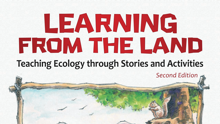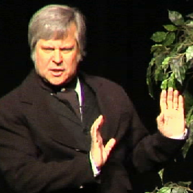How To Tell a Scary Story:
Storytelling Basics by Brian "Fox" Ellis
Storytelling Basics by Brian "Fox" Ellis

All of us, as librarians and teachers, are expected to have a scary tale or two up our sleeves. What can we learn from the craft of experienced storytellers? How can we apply the tricks of the trade to the scary stories of Halloween?
Think about some of your favorite storytellers, the performers who may have visited your school or library. What are some of the skills or techniques they use to captivate an audience, to bring a story to life? Different personalities tell stories differently. Some will make great sound effects while others will excel in movement and mime. The most important thing is to find a presentation style that suits your personality. With this said, there are a few general techniques to consider:
A GOOD INTRODUCTION needs to get their attention, get them ready to listen. Ease or jolt them into the tale. Begin with some history or background, something about the author, a song or poem or chant, or some intriguing sound effect.
Speak in a VOICE that is loud enough to be heard and clear enough to be understood. Speak with the feelings that are natural to the characters and situations involved in the story, not a melodramatic, syrupy voice. Feelings are usually best understated rather than over done. Speak with a lively voice, frequently changing tone, pace, and color. Most beginning storytellers speak too fast; it is best to let the words roll off of your tongue at a pace that allows listeners to relish the imagery. Accents can be very effective if used appropriately and accurately. If there is a witch in your story, cackle in a crackelly voice. If there is a giant, use a stern Old English accent.
Make SOUNDS. Sound effects, onomatopoeia, are a wonderful tool that adds humor and suspense. The sound of the wind raises goose bumps on the arms of the attentive audience. The squeaking door sends a shiver up the spine. Often sound effects are not written into literary tales. When translating a story from print to stage, look for places where you might add a well-chosen noise.
Use GESTURES and body language that are natural to your usual mode of communication. If you are the type of person whose hands start moving whenever you start talking then you will use more gestures than others. If not, don’t sweat it. Find a style that suits your personality. Sometimes knocking your knees or a little nervous twitch will add an extra dose of fear to the tale. Facial expressions are also a great tool for communicating emotions. Look at the audience the way you think the character might look. Walk the way you think the characters would walk. How does a hobbled old hag move? How does a fearless young maiden stand? Stand the way you think the character would stand.
The IMAGINATION is the most important tools in a storyteller’s bag of tricks. You must first imagine the character to know what voice or posture to use. You must first imagine the deep dark woods before you can bring the audience along. If per chance you loose your place in the story a healthy imagination will allow you to make it up as you go along! Use your imagination to live the story as you tell it.
When learning a new story, spend some time imagining each character, each scene, and each event. Close your eyes and imagine the order of events, that way when you tell the story the images are clear and the words are easy. Simply tell us what you see in your imagination. Do not memorize, remember. Allow yourself the freedom to improvise while maintaining the tone of the story. By reading and re-reading the story several times while focusing on the multi-sensory imagery, the story becomes a part of your experience and the words become the easy part.
We perceive the world in all of its richness through our SIX SENSES. In telling stories we help the audience create an imaginary world by engaging all of their senses. Describe your favorite Halloween candy flavors. Inhale deeply as you remind them of smells pleasant and profane. Specify the textures of clothes, leaves, the textures of moods and milieus. Stimulate the senses with noises: clap, stomp, hoot, and squeak. Draw elaborate word pictures in their minds. Open up your intuitive nature and tune into the audience. Watch carefully and listen attentively to their responses. Build on this invisible bond and carefully bring them under your magic spell!
Involve the AUDIENCE. Make eye contact! Ask questions like: Have you ever done this before? Do you know someone like this? Use local metaphors that compare elements of the story with tangible places, events and people, (e.g. as big as this room.) Ask them to repeat key lines with you like a chorus. Invite them to sing! Give them a job or make them a character.
 Watch the audience watch the story. Play with their disbelief or entice them to believe. It is very important that you are credible and their physical response will help keep you in check. As with any story, the art of a good telling involves the ability to suspend disbelief and enter into the story with complete conviction and integrity, even if they know it is a work of fiction. This is especially true with ghost stories. “Scaring” an audience can be as simple as quietly building suspense and then, BOO!, surprising them. This is more effective if you can enter into the tale and bring the audience with you. A ‘jump tale,’ is the simplest form of scary story. The whole point of the story is to draw in the listener and then spring the loud noise. Catch them off guard and they will jump! This works well when you hook the audience first.
Watch the audience watch the story. Play with their disbelief or entice them to believe. It is very important that you are credible and their physical response will help keep you in check. As with any story, the art of a good telling involves the ability to suspend disbelief and enter into the story with complete conviction and integrity, even if they know it is a work of fiction. This is especially true with ghost stories. “Scaring” an audience can be as simple as quietly building suspense and then, BOO!, surprising them. This is more effective if you can enter into the tale and bring the audience with you. A ‘jump tale,’ is the simplest form of scary story. The whole point of the story is to draw in the listener and then spring the loud noise. Catch them off guard and they will jump! This works well when you hook the audience first. After the story is complete have a neat and tidy ending. There are many classic endings that can be adapted. “And they all lived spookily ever after...” may be a little cheesy for some. Ghost stories usually end with a lingering fear like: “... so if you find yourself in these parts on a dark stormy night you might hear, Taily-Po, Taily-Po, I finally got my Taily-Po!” or “...and to this day folks always watch over their shoulder when the moon is full.”
Pause for a moment of silence. Bow and graciously accept their applause!
Beyond technique, the most critical element is your passion for the story. If you can tell the tale in a manner that conveys your excitement this contagious enthusiasm will be the key to a successful telling. Again, each of you are different and will tell stories differently. Some will make great spooky sounds while others will excel in scary faces and crazy caricatures. Find a style that feels comfortable to you. Try new things, experiment. Discard what does not fit and practice what feels right. Use your voice, body, and imagination together to TELL, not read, your story. With a little practice you too can tell a Halloween tale to the delight of audiences everywhere.
Fox has two CDs of ghost stories, River Ghost and Civil War Ghosts and Legends.
In the following bibliography I have focused on “tellable” stories with an emphasis on traditional storytelling material:
Children’s Picture Books
Galdone, Joanna. The Tailypo A Ghost Story. Illus. by Paul Galdone. 1977. 30p. The Seabury Press, $7.50 (0-8164-3191-4) Gr. 2 – 5.
Paul Galdone’s muted colors and backwoods details add an eerie tone to his daughter’s version of this classic tale in which a man eats the tale of a strange creature who in turn eats him. The use of sound effects and the overall pacing of the story are very effective. As a storyteller, it is always helpful to read several versions of a story and then put together your personal vision borrowing pieces from each.
Paul Galdone’s muted colors and backwoods details add an eerie tone to his daughter’s version of this classic tale in which a man eats the tale of a strange creature who in turn eats him. The use of sound effects and the overall pacing of the story are very effective. As a storyteller, it is always helpful to read several versions of a story and then put together your personal vision borrowing pieces from each.
Horton, Joan. Halloween Hoots and Howls. Illus. By JoAnn Adinolfi. 1999. 24p. Henry Holt and Company, $15.95 (0-8050-5805-2) Gr. 2 – 4.
These silly poems and bright illustrations are not just funny, they poke fun at childhood fears with a hint of true terror. As with all collections, some of the ideas work better than others, but there are more than enough homeruns to make this a worthwhile pick. It is fun to weave a poem or two into your performances of Halloween stories and these poems will help your audience to hoot and howl, moan and groan.
These silly poems and bright illustrations are not just funny, they poke fun at childhood fears with a hint of true terror. As with all collections, some of the ideas work better than others, but there are more than enough homeruns to make this a worthwhile pick. It is fun to weave a poem or two into your performances of Halloween stories and these poems will help your audience to hoot and howl, moan and groan.
Sierra, Judy. Wiley and the Hairy Man. Illus. by Brian Pinkney. 1996. 30p. Lodestar Books, $15.99 (0-525-67477-2)All Ages.
Wiley sure is wily in this story of him outsmarting the Hairy Man. This is simply the best version of this story available in print! Judy Sierra has published a study on various print version of Wiley and her scholarship shines through. She is also a storyteller whose experience with an audience is reflected in her vocabulary, tone, pacing, and attention to detail. Brian Pinkney’s scratch board illustrations create a colorful demon and vibrant swamp to add authenticity to this southern, black folktale.
Wiley sure is wily in this story of him outsmarting the Hairy Man. This is simply the best version of this story available in print! Judy Sierra has published a study on various print version of Wiley and her scholarship shines through. She is also a storyteller whose experience with an audience is reflected in her vocabulary, tone, pacing, and attention to detail. Brian Pinkney’s scratch board illustrations create a colorful demon and vibrant swamp to add authenticity to this southern, black folktale.
Wood, Douglas. The Windigo’s Return A North Woods Story. Illus. by Greg Couch. 1996. 29p. Simon & Schuster, $16.00 (0-689-80065-7)All Ages.
This was one of the first scary stories that I learned, not from Doug, but from an Ojibiwa Elder. Wood’s version is culturally accurate and eloquent. He is a great storyteller who is able to capture the ambience of the North Woods in this powerful story of a village working together to get rid of a menacing creature…but is it truly gone for good?
This was one of the first scary stories that I learned, not from Doug, but from an Ojibiwa Elder. Wood’s version is culturally accurate and eloquent. He is a great storyteller who is able to capture the ambience of the North Woods in this powerful story of a village working together to get rid of a menacing creature…but is it truly gone for good?
Collections for Younger Readers
Bang, Molly. The Buried Moon and other stories. Illus. by Molly Bang. 1977. 63p. Charles Scribner’s Sons, $5.95 (0-684-14666-5). Gr. 2- 5
The title story is my favorite, but all of the stories are tellable and written at a level that young readers can enjoy. Though the stories are a mix of original and traditional material they all have the ring of a folktale. In simple language with just the right amount of detail Bang deftly draws you in to feel the fear, but ends most stories on a high note to dissipate potential night mares.
The title story is my favorite, but all of the stories are tellable and written at a level that young readers can enjoy. Though the stories are a mix of original and traditional material they all have the ring of a folktale. In simple language with just the right amount of detail Bang deftly draws you in to feel the fear, but ends most stories on a high note to dissipate potential night mares.
Cole, Joanna and Calmenson, Stephanie. The Scary Book. Illus. by Chris Demarest, et al. 1991. 127p. Morrow Junior Books, $12.95 (0-688-10654-4)Gr. 2-5.
This is a funny, not scary, collection of stories, poems, jokes, riddles, tricks and games. Every teller of tales needs a few of these short poems, jokes and riddles as filler between longer stories. They also lighten the mood. It includes yet another version of Taily-po.
This is a funny, not scary, collection of stories, poems, jokes, riddles, tricks and games. Every teller of tales needs a few of these short poems, jokes and riddles as filler between longer stories. They also lighten the mood. It includes yet another version of Taily-po.
Schwartz, Alvin. Scary Stories to Tell in the Dark. Illus. by Stephen Gammell. 1981. 111p. Harper Trophy, paper, $3.95 (0-06-440170-7)
Schwartz, Alvin. More Scary Stories to Tell in the Dark. Illus. by Stephen Gammell. 1984. 100p. Harper Trophy, paper, $3.95 (0-06-440177-4)
Schwartz, Alvin. Scary Stories More Tales to Chill Your Bones. Illus. by Stephen Gammell. 1991. 115p. Harper Trophy, paper, $3.95 (0-06-440418-8)
These three books contain enough tellable tales to fill your programs with spooky stories for years to come. Alvin Schwartz was one of America’s pre-eminent folklorists who understood the depth and complexity of the material but wrote in such a simple manner that even the youngest readers can wade through many of these stories and poems. A few of the stories contain a bit too much gore for my tastes, but kids love them!
Schwartz, Alvin. More Scary Stories to Tell in the Dark. Illus. by Stephen Gammell. 1984. 100p. Harper Trophy, paper, $3.95 (0-06-440177-4)
Schwartz, Alvin. Scary Stories More Tales to Chill Your Bones. Illus. by Stephen Gammell. 1991. 115p. Harper Trophy, paper, $3.95 (0-06-440418-8)
These three books contain enough tellable tales to fill your programs with spooky stories for years to come. Alvin Schwartz was one of America’s pre-eminent folklorists who understood the depth and complexity of the material but wrote in such a simple manner that even the youngest readers can wade through many of these stories and poems. A few of the stories contain a bit too much gore for my tastes, but kids love them!
Young Dockrey, Richard and Judy. Favorite Scary Stories of American Children. 1990. 110p. August House, paper, $6.95 (0-87483-394-9)
If you buy one book this season, this should be it! This husband and wife team collected these stories from children they met on their travels across America as storytellers. These are indeed, as the title suggests, guaranteed to please most young audiences. These stories are also a wonderful reflection of our multiethnic culture with stories from Jewish, Cambodian, American Indian and African American traditions. The audio recordings are a superb accompaniment to the text.
If you buy one book this season, this should be it! This husband and wife team collected these stories from children they met on their travels across America as storytellers. These are indeed, as the title suggests, guaranteed to please most young audiences. These stories are also a wonderful reflection of our multiethnic culture with stories from Jewish, Cambodian, American Indian and African American traditions. The audio recordings are a superb accompaniment to the text.
Collections For Older Readers
'Brown Simpson, Roberta. The Walking Trees and Other Scary Stories. 1991. 139p. August House, paper, $7.95 (0-87483-143-1) Gr. 4-8'
Ms. Brown is the self-proclaimed queen of the cold blooded tale and this book helped her to earn this title. Though the plots tend to be formulaic, the details of each story still hook you in a way to set up the scare at the end.
Ms. Brown is the self-proclaimed queen of the cold blooded tale and this book helped her to earn this title. Though the plots tend to be formulaic, the details of each story still hook you in a way to set up the scare at the end.
Martin, Rafe. Mysterious Tales of Japan. Illus. by Tatsuro Kiuchi. 1996. 69p. G.P. Putnam’s Sons, $18.95 (0-399-22677-X) Gr. 4-12
This is by far the best collection of scary stories representing a single culture. Because Martin is a performing artist as well as a student of Zen, he has found a beautiful balance between scholarship and the oral tradition. “The Winter Wife” is my favorite story in this collection, (in part because I have heard Rafe’ perform it!), but all the tales are guaranteed to educate and entertain.
This is by far the best collection of scary stories representing a single culture. Because Martin is a performing artist as well as a student of Zen, he has found a beautiful balance between scholarship and the oral tradition. “The Winter Wife” is my favorite story in this collection, (in part because I have heard Rafe’ perform it!), but all the tales are guaranteed to educate and entertain.
McKissick, Patricia. The Dark Thirty. Alfred A. Knopf, NY 1992 Gr. 4-12
Another superb collection with a cultural theme, this book represents the wealth of African American scary stories. These stories are drawn directly from the oral tradition and translate well to performance. Subtle lessons in black history, racism and standing up to oppressors are woven through the stories in a manner that adds to their strength and makes the fear factor more gripping.
Another superb collection with a cultural theme, this book represents the wealth of African American scary stories. These stories are drawn directly from the oral tradition and translate well to performance. Subtle lessons in black history, racism and standing up to oppressors are woven through the stories in a manner that adds to their strength and makes the fear factor more gripping.
Poe, Allen Edgar. Poe’s Tales of Mystery and Terror. 1967. 319p. Magnum Books, paper, $2.95 Gr. 7 – 12.
No library is complete without at least one collection of Poe’s work. Beyond “The Raven” and “The Tell-Tale Heart” Poe has written dozens of stories that are difficult to tell well, but well worth the effort if you want to haunt your audience with true terror!
No library is complete without at least one collection of Poe’s work. Beyond “The Raven” and “The Tell-Tale Heart” Poe has written dozens of stories that are difficult to tell well, but well worth the effort if you want to haunt your audience with true terror!
Luckhardt, Corell Mildred. Spooky Tales about Witches,Ghosts, Goblins Demons, and Such. Illus. by Ralph McDonald. 1972. 223p. Abingdon Press, (0-687-39256-X) Gr. 5 and up.
Most libraries contain dozens of collection of this nature, too many to list here. Though literary by nature all of them contain at least a few tellable tales. From Shakespeare’s “Witches Chant” to Isaac Bashevis Singer’s retelling of a Yiddish folktale this collection contains several performable stories.
Most libraries contain dozens of collection of this nature, too many to list here. Though literary by nature all of them contain at least a few tellable tales. From Shakespeare’s “Witches Chant” to Isaac Bashevis Singer’s retelling of a Yiddish folktale this collection contains several performable stories.
Young Dockrey, Richard and Judy. Scary Story Reader. Illus. by Wendell E. Hall. 1993. 174p. August House, paper, $9.95 (0-87483-382-5) Gr. 4 – 8
Like their collection for younger readers, this is an excellent assortment of stories gathered from the oral tradition. Geared specifically to upper elementary and middle school students there is a great mix of gross and ghoulish in these well told tales.
Like their collection for younger readers, this is an excellent assortment of stories gathered from the oral tradition. Geared specifically to upper elementary and middle school students there is a great mix of gross and ghoulish in these well told tales.
Brian “Fox” Ellis is a professional storyteller, author of twelve books and frequent performer of spooky stories. To book a program Contact Fox.









